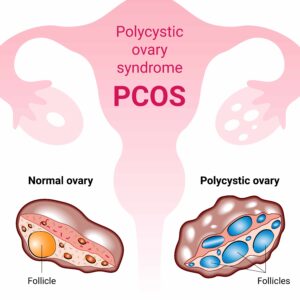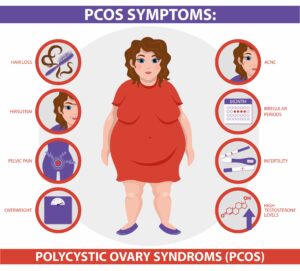Polycystic Ovary Syndrome (PCOS)
Overview
It is quite unbelievable to have a condition that touches almost one in ten females out there and get to know about it at the wrong side of the divide when it starts impacting negatively on your life. PCOS is a silent endocrine condition that is marked by a range of symptoms that are as minor as having a bloated belly or acne but can be as severe as resulting in infertility and life-threatening metabolic problems.
Although PCOS is quite common, it remains diagnosed and frequently unrecognized, which means that a multitude of women suffering from this condition remains unknown. Based on the information presented in the article, it can be concluded that PCOS is a multifaceted condition that affects a significant number of women, and that this article aims to give a ray of hope to those women by providing a detailed description of the symptoms, diagnosis, possible complications, and treatment possibilities. Whether it is a woman suffering from PCOS herself or it is the parents of a kid suffering from PCOS, it is very important that they have some idea about this condition, which is necessary for the basic management of the problem and to make life easier for them.
Definition of PCOS:

Polycystic Ovary Syndrome, better known as PCOS, is an endocrine disorder that affects those with ovaries, most women in childbearing age. The disease is defined by a cluster of features and anomalies touching upon hormones such as androgens and insulin. The syndrome’s name comes from the multiple cysts in the ovaries, although not all women diagnosed with PCOS will have cysts. PCOS also affects an individual’s health, including the frequency of menstruation, hormonal balance, and metabolism. It is a syndrome with numerous aspects that must be considered during diagnosis and treatment.
Prevalence:
Type 2 PCOS is one of the leading endocrine disorders in women, with statistics showing that up to 18 million women of childbearing age worldwide suffer from the condition, although a global prevalence ranging from 6% to 12% has been reported. It was noted that the great variability of prevalence rates may be related to differences in the samples of subjects investigated and differences in criteria for diagnosing the disease. Recent research shows that about 5–12 percent of women suffer from the condition that is PCOS. This high prevalence therefore underlines the need for increased awareness in order to ensure appropriate early intervention to manage the symptoms, as well as appropriate intervention to minimize the risk of these associated complications.
Awareness is important.
It is important to increase the awareness of the public in relation to the presence of PCOS, given the fact that the condition has a great impact on a person. From the onset, the disease remains untreated and may result in other related complications such as fertility problems, metabolic disorders, and mental illness. Knowledge can assist a person in not only identifying signs of such disorders at an early stage, but also in getting proper treatment and controlling the problem. Furthermore, knowledge of this condition can help patients adhere to positive behavioral changes regarding the illness, practice preventive measures, and improve their quality of life.
Symptoms of PCOS

Irregular menstrual cycles:
PCOS is also characterized by abnormal menstruation, one of its defining features. This can manifest in two primary forms: This can manifest in two primary forms:
- Oligomenorrhea: This is a menstrual cycle with fewer than eight cycles in a year, and this is due to the reduced frequency of occurrence. The amenorrhea can be light, irregular, or sparse, though the minimum possible interval between two consecutive menses should be 35 days.
- Amenorrhea: failure to menstruate for three or more months/primary amenorrhea. This can be especially disconcerting for those women who have enjoyed at least relatively regular periods in the past.
This is due to hormonal imbalances, which often lead to complications in the fertility and reproductive systems.
Hyperandrogenism:
Hyperandrogenism is when women’s levels of androgens, hormones that are more characteristic of men, increase. In PCOS, increased levels of androgens can lead to several noticeable symptoms: In PCOS, increased levels of androgens can lead to several noticeable symptoms:
- Hirsutism: overgrowth of body hairs in parts that have been considered dominantly containing male-pattern hairs, for instance, the face, chest, and back. This can be upsetting and really do a number on a person’s self-esteem.
- Acne and Oily Skin: Androgens are associated with enhanced seborrhea and acne later in life. This is because estrogen levels are linked to acne persistence, and increased sebum production causes inflammation. These symptoms are usually persistent and do not respond to normal acne treatments.
- Androgenic Alopecia: temporary or permanent hair loss or alopecia of the scalp, which may be quite embarrassing to people experiencing the situation.
Polycystic Ovaries:
The presence of multiple cysts in the ovaries is a characteristic feature of PCOS, although not all individuals will have visible cysts. The presence of multiple cysts in the ovaries is a characteristic feature of PCOS, although not all individuals will have visible cysts.
- Enlarged Ovaries: there may be an enlargement of the ovaries in which numerous small follicles can be identified by the ultrasound examination.
- Cysts: In women with PCOS, fluid-containing cysts are common, particularly in the ovaries. Some cysts are small and asymptomatic, but they help detect these disorders.
Insulin Resistance and Hyperinsulinemia:
Insulin resistance is a common metabolic abnormality in PCOS, leading to: Insulin resistance is a common metabolic abnormality in PCOS, leading to:
- Insulin Resistance: When a cell in the body becomes resistant to the hormone insulin, blood sugar levels rise. The present researchers also revealed that it could also result in a higher influx of type 2 diabetes incidences.
- Hyperinsulinemia: high levels of insulin in the blood due to the body trying to correct the issue of insulin sensitivity. Hyperinsulinemia can make other symptoms worse, like weight gain and hirsutism in women with PCOS.
Weight gain and obesity:
Many individuals with PCOS experience weight gain and obesity, particularly in the abdominal area.Many individuals with PCOS experience weight gain and obesity, particularly in the abdominal area.Central Obesity: lipotoxicity that refers to excess accumulation of lipids in the liver and causes non-alcoholic steatohepatitis; obesity contributes to fat, particularly around the abdomen, which raises the probability of metabolic syndrome and cardiovascular diseases.
Difficulty Losing Weight: Most people with PCOS often have the problem of weight loss even when they have diets, live well, and exercise. This may primarily be due to hormonal imbalances and insulin resistance.
Skin Changes:
PCOS can lead to several skin-related changes:PCOS can lead to several skin-related changes:Acanthosis Nigricans: This is a skin discoloration, usually associated with black, brown, or shades of the two in hidden areas like the neck, groin, armpits, and other crevices. This condition is an indication of what is referred to as insulin resistance.
Skin Tags: benign skin tumors that are normally found in those areas of the skin where there is usually pressure or rubbing, like the neck and the axillae.
Mood Disorders:
PCOS can also affect mental health, leading to:PCOS can also affect mental health, leading to:Depression: For the present moment, a depressed person can have a low mood, lack of motivation, and lack of energy. Depression is common in women with PCOS; therefore, there is a need to investigate their cognitive functioning.
Anxiety disorders are persistent and chronic mental health disorders that involve worrying, anxiety, and fear, which restrict the person’s daily routine and quality of life.
Sleep Disturbances:
PCOS can lead to various sleep-related issues:PCOS can lead to various sleep-related issues:Sleep Apnea: A condition where breathing is partially disrupted during sleep and results in tiredness during the day and other health complications.
Insomnia: Poor quality sleep involving a hard time to get to sleep or to remain asleep, which has impacts on the physical and emotional well-being of an individual.
Fertility Issues:
PCOS is a common cause of fertility problems due to:PCOS is a common cause of fertility problems due to:Anovulation: When there is no ovulation, which is needed to have conception. These anovulation problems make it challenging for some individuals to become pregnant.
Miscarriage: It increases the risk of miscarriage because of hormonal imbalances and other PCOS characteristics.
Diagnosing PCOS
Clinical assessment and medical history:
A complete clinical assessment is needed to diagnose PCOS.
- Symptom documenting: detailed documenting of symptoms, including menstrual abnormalities, evidence of hyperandrogenism, and metabolic problems. This information assists in estimating the possibility of PCOS.
- Family History: A family history of PCOS or associated diseases might give helpful insights into the diagnosis. PCOS commonly runs in families, and recognizing familial patterns might assist in diagnosis.
Physical Examination:
The physical examination focuses on finding indications of PCOS:
- Hirsutism Assessment: Excessive hair growth is evaluated using the Ferriman-Gallwey scoring system, which rates the amount of hirsutism.
- Skin Examination: Checking for acne, greasy skin, acanthosis nigricans, and skin tags.
Measurement of body mass index (BMI) and waist circumference to measure obesity and metabolic risk.
Blood Tests:
Blood tests are critical for evaluating hormonal and metabolic abnormalities.
- Hormone Levels: Measurement of androgens (e.g., testosterone), luteinizing hormone (LH), and follicle-stimulating hormone (FSH). Elevated androgen levels and an abnormal LH-to-FSH ratio are symptoms of PCOS.
- Glucose and Lipid Tests: To measure insulin resistance and metabolic risk, evaluate fasting glucose, insulin levels, and lipid profiles.
Pelvic Ultrasound:
Pelvic ultrasonography helps view the ovaries and diagnose cysts.
- Transvaginal ultrasound provides comprehensive pictures of the ovaries and can reveal the existence of numerous follicles or larger ovaries.
- Criteria for Polycystic Ovaries: Diagnosis may be supported by identifying 12 or more follicles in each ovary or increased ovarian volume.
Diagnostic Criteria:
The diagnosis of PCOS is based on established criteria:
- Rotterdam Criteria: Requires the presence of at least two of the following three features: irregular ovulation, hyperandrogenism, and polycystic ovaries.
- Differential Diagnosis: It is crucial to rule out other problems that might present with similar symptoms, such as thyroid disorders, hyperprolactinemia, congenital adrenal hyperplasia, and Cushing’s syndrome.
Potential Complications of Untreated PCOS
Infertility:
Untreated PCOS can lead to major reproductive issues.
- Anovulation: The absence of ovulation might make it tough to conceive.
- Irregular Ovulation: Irregular ovulation might result in difficulty timing intercourse and increase the odds of pregnancy.
Metabolic Syndrome:
PCOS is strongly connected with metabolic syndrome, which includes:
- Insulin Resistance: Elevated insulin levels and impaired insulin sensitivity can lead to metabolic syndrome.
- Obesity: In PCOS, central obesity is common and can increase insulin resistance.
- Dyslipidemia: Abnormal lipid levels, especially high cholesterol and triglycerides, increase cardiovascular risk.
Type 2 diabetes:
Individuals with PCOS have an increased risk of getting type 2 diabetes owing to:
- Raised blood glucose levels: Insulin resistance can lead to raised blood glucose levels, increasing the risk of diabetes.
Cardiovascular Disease:
PCOS can raise the risk of cardiovascular disease.
- Hypertension: Patients with PCOS typically have high blood pressure, which is a typical concern for patients with PCOS.
- Dyslipidemia: Abnormal cholesterol levels add to cardiovascular risk.
- Inflammation: Chronic low-grade inflammation linked with PCOS might significantly raise cardiovascular risk.
Endometrial Hyperplasia and Cancer:
Untreated PCOS can lead to:
- Endometrial hyperplasia: Thickening of the uterine lining caused by prolonged exposure to unopposed estrogen.
- Chance of endometrial cancer: Prolonged endometrial hyperplasia raises the chance of developing endometrial cancer.
Psychological Issues:
PCOS may impair mental health, leading to:
- Depression: persistent emotions of melancholy and loss of interest in activities.
- Anxiety: excessive concern and anxiousness disrupt daily living.
- Low self-esteem: body image concerns and self-esteem problems owing to physical ailments like hirsutism and acne.
Sleep Apnea:
PCOS can contribute to sleep disturbances.
- Interrupted Breathing: Sleep apnea causes recurrent disruptions in breathing during sleep, which can have an impact on overall health.
- Poor Sleep Quality: Poor sleep quality can contribute to daytime weariness and other health complications.
Non-Alcoholic Fatty Liver Disease (NAFLD):
PCOS raises the risk of NAFLD.
- Liver Inflammation: Fat buildup in the liver can induce inflammation and liver damage.
- Liver damage: Prolonged NAFLD can lead to more serious liver diseases.
Increased Risk of Miscarriage:
PCOS can increase the chance of miscarriage.
- Hormonal Imbalances: Pregnancy outcomes can be influenced by hormonal imbalances.
- Endometrial Health: Abnormalities in the endometrial lining might lead to miscarriage risk.
Treatment options for PCOS
Lifestyle Modifications:
Lifestyle adjustments are key to controlling PCOS.
Diet and Nutrition:
- Balanced Diet: Emphasis on a well-rounded diet with a range of nutrients.
- Foods with a Low Glycemic Index: Choosing foods with a low glycemic index can help you regulate your blood sugar levels.
- Portion Control: Managing portion sizes to help weight management.
Physical Activity:
- Regular Exercise: Engaging in regular physical activity helps enhance insulin sensitivity and manage weight.
- Consistency: maintaining a regular training practice for long-term advantages.
Stress Management:
- Mindfulness Practices: Incorporating mindfulness practices, such as meditation and yoga, to manage stress.
- Adequate Sleep: To promote overall health, ensure adequate and quality sleep.
Medications:
Various drugs can help control PCOS symptoms.
Hormonal Contraceptives:
- Oral contraceptives: birth control tablets help regulate menstrual periods and lower testosterone levels.
- Progestin Therapy: Hormonal therapy to address menstrual abnormalities.
Anti-Androgen Medications:
- Spironolactone is a medicine that helps lessen symptoms of hyperandrogenism, such as hirsutism.
- Flutamide is another anti-androgen medicine that can help treat symptoms, including acne and hair loss.
Insulin-Sensitizing Agents:
- Metformin is a drug that enhances insulin sensitivity and helps regulate blood sugar levels.
- Thiazolidinediones are another family of medicines that can increase insulin sensitivity.
Ovulation Induction:
- Clomiphene Citrate: A drug used to induce ovulation in women with PCOS.
- Letrozole is an alternative to clomiphene citrate for initiating ovulation.
Fertility Treatments:
For those wanting to conceive:
Ovulation Induction:
- Clomiphene Citrate and Letrozole: Medications to Promote Ovulation and Improve Fertility.
- Gonadotropins: injectable hormones to further stimulate the ovaries.
Assisted Reproductive Technologies (ART):
- In Vitro Fertilization (IVF): A method where eggs are fertilized outside the body and subsequently placed in the uterus.
Surgical Options:
Surgical procedures may be considered:
Ovarian Drilling:
- Laparoscopic Ovarian Drilling (LOD) is a minimally invasive surgery to lower androgen levels and improve ovulation.
Management of Psychological Symptoms:
Addressing mental health is crucial.
Counseling and therapy:
- Cognitive behavioral treatment (CBT) is a kind of treatment that can help manage depression and anxiety.
- Support Groups: Joining groups for shared experiences and support.
Medication:
- Antidepressants: medications to control symptoms of depression.
Anti-Anxiety Medications: To assist in controlling anxiety symptoms.
Alternative and complementary therapies:
Some people may seek complementary treatments:
Supplements:
- Inositol is a vitamin that may aid with insulin sensitivity and ovarian function.
- Vitamin D is essential for general health and may assist hormonal balance.
Herbal Remedies:
- Spearmint tea is known for its potential to alleviate hirsutism.
- Cinnamon may help increase insulin sensitivity.
Quick Review
Summary of Key Points:
Polycystic Ovary Syndrome (PCOS) is a complicated hormonal condition that affects a substantial number of women globally. It is characterized by a spectrum of symptoms, including irregular menstrual periods, hyperandrogenism, and polycystic ovaries. The disorder can lead to many consequences if left untreated, including infertility, metabolic syndrome, and cardiovascular disease. Effective treatment includes a mix of lifestyle adjustments, medicines, and, in some circumstances, surgical procedures. Addressing psychological issues and investigating other therapies may also be effective. Early diagnosis and extensive treatment are critical to improving outcomes and quality of life for PCOS patients.
Importance of Early Diagnosis and Management:
Early detection and treatment of PCOS can prevent the progression of symptoms and lower the risk of long-term problems. Recognizing the indicators and seeking medical care allows for timely intervention and the adoption of successful treatment techniques. This strategy can help control symptoms, promote fertility, and boost overall health.
Encouragement for ongoing support and treatment:
PCOS is a lifelong disorder that requires continual care and assistance. Individuals are advised to engage closely with healthcare practitioners to build a specific treatment plan and to seek help from healthcare experts, support groups, and mental health services. Ongoing therapy and lifestyle improvements can greatly improve results and help patients enjoy healthier, happier lives.











One Comment